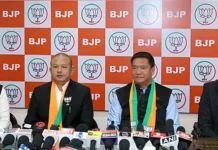[ Tongam Rina ]
ITANAGAR, Mar 14: In news that will cheer up wildlife enthusiasts, Chief Minister Pema Khandu has said that he has asked the PWD commissioner to review the proposed East-West Industrial Corridor road, proposed to be laid through the heart of the Pakke Tiger Reserve (PTR) to connect Seijosa in Pakke-Kessang district with Bhalukpong in West Kameng.
Responding to questions from this daily, the chief minister said he has asked the PWD commissioner to review the road project and brief him, “so that early strategy can be worked out.”
“Pakke Tiger Reserve is not only home to the tigers but also one of the biodiversity hotspots of the country and home to scores of endangered species,” Khandu said.
On 2 March, responding to a query from this daily, the CM had said that he would take up the issue with the forest department and the executing agency.
According to the DPR which was presented to the high-powered committee (HPC) on the road project, Ahmedabad (Gujarat)-based consultancy firm, Nektor Engineers & Project Consultants (NEPC) had proposed an elevated corridor that would pass through the 40 km stretch from Seijosa to Bhalukpong through the PTR.
The consultants gave three options for the road: via Pakke Kessang-Seppa-Nechiphu; via Pakke-Kessang and Nechiphu; and through the PTR.
The forest department was not consulted by the NEPC before the finalization of the DPR.
Responding to a query from this daily, the NEPC had said that it used satellite imageries for finalization of the DPR after the forest department had turned down the request to let them inside the park.
Meanwhile, the proposed elevated corridor had alarmed many.
Scientists and allied professionals who have undertaken research on the biodiversity of the Pakke Wildlife Sanctuary and Tiger Reserve had written to the authorities, expressing concern over the proposed road/highway through the PTR.
They said that any plans for a proposed road should be realigned so that no road/highway is constructed through the PTR, as it would be highly detrimental to the future of the sanctuary/tiger reserve, cause destruction of a highly important forest habitat, and lead to fragmentation of an intact ecosystem.
The Nameri Tiger Reserve in Assam shares its boundary with the PTR along the southern side. The parks are designated as critical tiger habitats.
Bollywood actor Dia Mirza is one of those who have raised concern over the proposed road.
Earlier, Rajen Tachang, who hails from Seijosa, said in a message to this daily that “Pakke is truly a paradise as it is still untouched by human interference. Once humans interfere with it, it will not remain the same and there will be no cure, whatsoever we try afterwards.”
“If the highway project is implemented, it will bring more harm than good to the Pakke Tiger Reserve, which is one of the last untouched and wild terrains not just in India, but in the world,” he said.
Feppy Tayam, a forestry student opposing the road project, said that with the proposal of the highway through the heart of Pakke, “it would no longer be the same as it today.
“It will not only cause human-animal conflicts but also destroy the forest, as well as lead one step ahead to endangered, critically endangered, and extinction of flora and fauna, since Pakke is one of the last remaining strongholds left for the flora and fauna,” Tayam said.
Laxmi Langlang, a researcher, said that “the proposed highway through the PTR endangers one of the most biodiverse and rich forests of India. The road and resulting bridges will give access to illegal hunting, logging and poaching. The road would need removal of large tracts of trees which have taken many years to grow and support the forest.”
She said that, being a native of the region, she understands that the development concerns of the people are valid but the highway cannot play any significant role in its development.
Environmental activist Tana Jorjo Tara while speaking to this daily said that he would go to court if the government did not rethink the proposed elevated corridor.
According to information procured through the RTI Act by Tana Jorjo Tara, the PTR’s DFO, Tana Tapi, had in a letter to the highway department’s chief engineer in July 2018 suggested that an alternative route be taken up instead laying one through the PTR, citing the Forest Conservation Act (FCA) and the Wildlife Protection Act (WPA), 1972.
The objection raised by the DFO has been noted in the DPR by the consultant.
Under the FCA, any kind of survey, investigation and exploration is not permitted to be carried out inside national parks and wildlife sanctuaries by any agency. Even the forest department is not permitted to demarcate sample plots without obtaining prior approval of the National Board of Wildlife (NBWL) and the Supreme Court.
Under the WPA, no alteration in the boundary of a tiger reserve shall be made, except on recommendation of the National Tiger Conservation Authority and the approval of the NBWL.
The NEPC did not seek any kind of permission from the forest department in Itanagar, or from the PTR DFO, before finalizing the draft DPR. The NEPC, which was denied entry into the park, had instead asked the forest department to help in getting clearance according to the DPR.
According to the laid down guidelines, the DPR is in violation the ministry of environment, forest & climate change (MoEFCC) guidelines as prior permission is required from the forest department before undertaking any activity within protected areas.
In a letter it sent to the chief wildlife wardens of all the states and union territories, the MoEFCC said all the linear infrastructure projects seeking clearance from the standing committee of the NBWL “must mandatorily contain an animal passage plan,” and that if there is no plan, such proposals should not be sent to the NBWL. The letter was sent in July 2018.
In May 2019, the road, transport & highways ministry in a letter to the chief secretaries of the states and the BRO on the principles to be adopted while considering constructing highways near or within wildlife sanctuaries, national parks and animal corridors said that in order to ensure minimum impact of highways on protected eco-sensitive areas, the implementing agency should consider sparing sanctuaries and national parks at the planning stage and, wherever possible, take a bypass/detour.
On 5 February this year, the HPC approved the DPR for the East-West Industrial Corridor. The road project was conceived in 1990, and would pass through East Siang, Lower Siang, Kamle, Papum Pare, East Kameng and West Kameng districts.
The 692.70 km long industrial corridor would run along the foothills on the boundaries of Arunachal and Assam.




